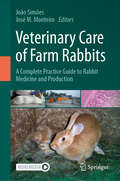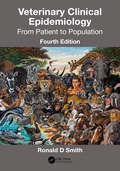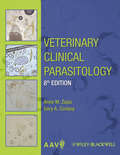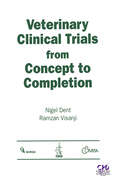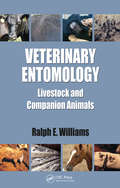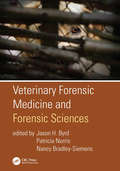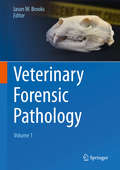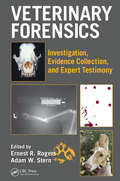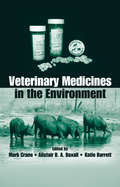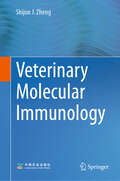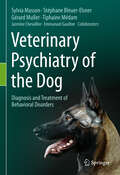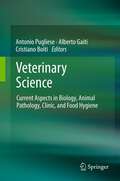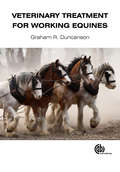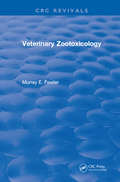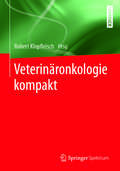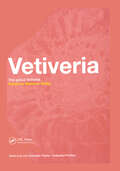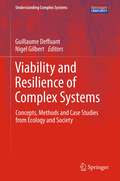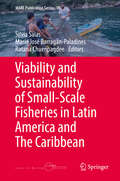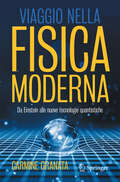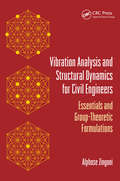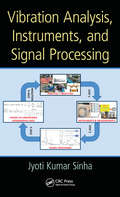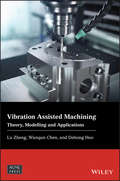- Table View
- List View
Veterinary Care of Farm Rabbits: A Complete Practice Guide to Rabbit Medicine and Production
by João Simões José M. MonteiroThis holistic guide brings rabbit production science and medicine together. It considers the full spectrum of commercial rabbit husbandry, including intensive, semi-intensive, and organic systems for meat, fur and leather. Drawn from an international authorship, the book addresses practical and fundamental topics. In comprehensive sections, readers will find easy-to-read chapters on:• rabbit breeds, anatomy essentials and lagomorph physiology• rabbit production with details on animal facilities and farm design, international trading, rabbit meat processing and biosafety, including a vivid appendix on meat inspection• rabbit herd and health management, considering latest findings in welfare and behavior, preventive medicine, antimicrobial resistance and demedication to necropsy and specimen collection• significant rabbit diseases, covering encephalitozoonosis cuniculi, rabbit enteropathies, and many more• complete veterinary treatment, supplemented by reference ranges and interpretation of hematological and biochemical valuesBesides an increasing keeping of pet rabbits, the animals are gaining interest for sustainable food production, leading to a rise in farming in various parts of the world. In this context, the present guide provides valuable contributions for consulting veterinarians and students, industry professionals, breeders and technicians, as well as for experts from the small and companion animal sector.The relevance of rabbit farming from the viewpoints of greenhouse gas reduction and sustainable use of ecological resources (use of local feed) also creates useful links for readers interested in the sustainable development goals SDG 2 (Zero Hunger) and SDG 12 (Responsible Consumption and Production).
Veterinary Clinical Epidemiology: From Patient to Population
by Ronald D. Smith4* Doody's Review! Ideal for veterinary students, residents and clinicians, the fourth edition of this bestselling textbook has been fully updated in line with developments in research and teaching. The logical chapter progression reflects the stages in a clinical case work-up and how epidemiological concepts and methods contribute. This new edition provides guidelines for improving patient and population health outcomes, and detecting emerging diseases through systematic evaluation of patient encounters and electronic medical records incorporates new methodologies and concepts drawn from the recent veterinary practice literature updates chapter content including expanded coverage of risk, statistical and economic analyses, and surveillance for emerging diseases more than 60 examples of clinical research drawn from the international veterinary practice literature presented as structured abstracts; follow-up questions invite the reader to participate in the analysis of results online links to full text versions of more than half of structured abstracts and more than 40% of the book’s 174 literature citations updates the listing and review of public and private online resources, including guidelines for online literature searching and critical evaluation of clinical reports. Today’s veterinary curricula places greater emphasis on experiential/problem-based learning versus discipline-oriented instruction. This fourth edition is ideally suited to introduce epidemiologic concepts and methodologies to veterinary students in the context of the patient encounter, and should be of use at any point in the veterinary curriculum.
Veterinary Clinical Parasitology (7th edition)
by Anne M. Zajac Gary A. ConboyPeacocks can carry Ascaridia eggs while ducks and wild birds carry another ascarid genus. Mites can fool you because they are laterally compressed like fleas. Designed for desk reference but suitable for quick reviews and clinical practice, this guide focuses on morphologic identification of parasites in domestic animals, featuring accurate and cost-effective means of diagnosing parasitic infections. With over 400 color photographs and a layout ideal for field work, this covers the fecal examination for diagnosis, including collection, storage, shipment, exam procedures, use of the microscope, techniques for evaluation in grazing animals, identification of adult worms, and parasites of domestic animals. It also covers detection of protozoan and Helmith parasites in the urinary, reproductive and integumentary systems and in the eye, detection of parasites in the blood, diagnosis of arthropod parasites such as lice, fleas, flies, mites and ticks, and parasites of fish. Annotation ©2006 Book News, Inc. , Portland, OR (booknews. com)
Veterinary Clinical Trials From Concept to Completion
by Nigel Dent Ramzan VisanjiConceived and edited by Nigel Dent and Ramzan Visanji, Veterinary Clinical Trials form Concept to Completion is designed for both established practitioners and novices, offering alternative ways of conducting studies and ensuring that the studies are guided by Good Clinical Practices and are in compliance with regulations. Comprehensive in scope, i
Veterinary Entomology: Livestock and Companion Animals
by Ralph E. WilliamsLivestock production systems and some husbandry practices are prone to producing veterinary important entomological concerns. In addition, various arthropod-borne diseasessuch as West Nile and some types of encephalitiscan affect both humans and animals. To circumvent these problems successfully, a solid understanding of veterinary entomology shoul
Veterinary Forensic Medicine and Forensic Sciences
by Jason H. Byrd Patricia Norris Nancy Bradley-SiemensWhile there are several recent books on this emerging field, Veterinary Forensic Medicine and Forensic Sciences sets the bar, covering all relevant aspects in a succinct, easy-to-read, comprehensive format designed to be taught in a single-semester course. Intended to be the premier textbook on veterinary forensic sciences, the book covers the application of veterinary forensic medicine to cases, including the medical perspective as well as law enforcement response, crime scene management, and evidence recovery issues. Coverage includes the scientific and legal principles for veterinary forensic evidence. This clearly delineates it from veterinary-only practices, since the forensic aspects present additional challenges that include evidence recovery and preservation, report writing, and maintaining an evidentiary chain of custody, all the way through expert witness testimony. Some emerging topics that are covered include DNA and genetic evidence, entomological evidence in support of veterinary forensics, animal fighting, situational deaths, including poisonings, domestic violence, and cruelty, sharp and blunt force trauma, gunshot and wound ballistics, sexual assault, nonhuman odontology and osteology, and more. Features Details a process for forensic science case management for humane law enforcement agencies Presents multiple chapters on specific types of trauma analysis in animals Provides developments on current trends in forensic entomology as applied to wildlife crime and minimum postmortem interval determinations Explores national and international considerations in combating organized animal fighting Offers DNA applications for wildlife crime and environmental monitoring Outlines current animal and environmental forensic toxicology legal casework This text offers a straightforward presentation of current practices and includes several real-world case examples throughout to illustrate concepts. Fully illustrated with more than 280 full-color images, Veterinary Forensic Medicine and Forensic Sciences provides the latest in advances and up-to-date field techniques, applicable for student instruction in the classroom and beyond.
Veterinary Forensic Pathology, Volume 1
by Jason W. BrooksThis richly illustrated two-volume book offers a comprehensive and essential reference guide for veterinary pathologists and clinical veterinarians interested in performing animal necropsies for forensic casework. It presents a broad range of animal crime cases, with particular focus on the post mortem examination and the observed pathology. This first volume introduces readers to veterinary forensics and the role of the veterinary pathologist in animal crime investigations. It guides them through the process of evidence collection and documentation, and covers the fundamentals of forensic necropsy and the estimation of time since death. In-depth descriptions of how to conduct the forensic evaluation of various traumatic injuries, firearm injuries, and asphyxia are also provided.
Veterinary Forensics: Investigation, Evidence Collection, and Expert Testimony
by Ernest Rogers Adam W. SternVeterinary Forensics: Investigation, Evidence Collection, and Expert Testimony will provide anyone involved in an investigation of an animal involved crime or civil action with the knowledge and tools that can give guidance for their actions in completing a forensic investigation. All 50 U.S. states, and numerous countries around the world, have laws against animal abuse and cruelty. Law enforcement agents, veterinarians, the judiciary, attorneys and forensic scientists may be involved in cases of animal cruelty, neglect or human crimes that may have an animal element. Additionally, the animal can be the victim, suspect or in some instances the witness of a crime. Given that acquittal or conviction is dependent upon the nature and veracity of the evidence, the quality of the evidence in an animal-related crime investigation must be beyond reproach. The book begins with a discussion of animal abuse and crimes against animals, crime scene investigation, and, from there, discusses various types of forensic examinations of the animal, culminating in a review of the judicial system and testimony in a court of law. All contributing authors are practicing professionals in law, veterinary medicine, and the private sector who provide current, best-practice evidence collection and forensic techniques. Chapters provide in-depth detail about the forensic clinical examination and forensic necropsy of small and large animal species, forensic radiology, forensic toxicology, bitemark analysis and animal behavior. Various, relevant forensic disciplines such as bloodstain pattern analysis, DNA analysis, animal sexual abuse, agroterrorism, animal hoarding, ritual crimes against animals, and animal fighting are discussed. Key Features: Presents established and accepted police techniques in animal crime scene investigation including identification, documentation and packaging of physical evidence and scene photography and videography Includes essential techniques to collect and preserve biological and DNA evidence for animal DNA testing Review of the forensic clinical examination and forensic necropsy of small and large animals Provides methods of evidence presentation in the courtroom, the nature of court room testimony, and the development of an expert report Veterinary Forensics: Investigation, Evidence Collection, and Expert Testimony fills the void of applied, real-world investigative techniques for the collection and presentation of veterinary forensic medical and scientific information. It will be a welcome reference to both the student and professional in the understanding all relevant evidentiary, investigative, and legal elements of the discipline.
Veterinary Medicines in the Environment
by Mark Crane Alistair B. A. Boxall Katie BarrettExamine the Current State of the ScienceSurface water sampling programs across the globe have shown the presence of many different classes of medicines. The potential risks associated with the release of these medicines into the environment have become an increasingly important issue for environmental regulators. Effects of Veterinary Medicines in
Veterinary Molecular Immunology
by Shijun J. ZhengThis book focuses primarily on the newly discovered theory and techniques of veterinary molecular immunology. It also covers application of modern immunological methods into the treatment and control of infectious diseases and cancer, and future research trends. In terms of new immunological theories, this book focuses on recently-discovered innate lymphocytes (ILCs), signal transduction triggered by engagement of pattern recognition receptors (PRRs) with pathogen-associated molecular patterns (PAMPs), and signal communication between nerve and immune systems, antimicrobial peptides, immunoregulation and checkpoint, development and maturation of T and B lymphocytes, regulatory T cells, immune tolerance, and immunosuppression and evasion. In terms of new techniques and application, the book covers the categories and designs of preventive and therapeutic vaccines and the principle of developing vaccination program, occurrence, development and immune evasion of cancer cells, and the novel techniques for cancer therapy. In addition, comparison of avian and porcine cytokines with human and mouse ones is also provided in the appendices to illustrate the differences in cytokines between species. This book is valuable for the undergraduates, graduate students or professional researchers with requirement for advanced studies in veterinary immunology. It meets their requirements for improving and expanding knowledge of immunology.
Veterinary Psychiatry of the Dog: Diagnosis and Treatment of Behavioral Disorders
by Sylvia Masson Stéphane Bleuer-Elsner Gérard Muller Tiphaine Medam Jasmine Chevallier Emmanuel GaultierThis richly illustrated textbook delivers a functional vision of dog behaviors. Daily applicable, it offers practical solutions for canine behavioral care with a consistently medical approach to disorders. Readers find a thorough introduction to factors influencing behavior, the canine neuroanatomy and physiology, psychopathologies, as well as treatment options. Drawing on the latest studies in neuroscience, ethology, psychology, and psychiatry, as well as the clinical experience of its expert authors, this guide is both comprehensive and accessible. Multiple clinical case studies illustrate and support presented details on medication and therapies.Behavioral pathology is one of the main challenges in veterinary medicine. Not only are they a cause of suffering for the animal, but they can also affect the quality of the relationship with the pet owners or pose a danger to society. Hence, treatment of these behavioral disorders requires an integrative approach to canine healthand well-being.The book's easy-to-access and descriptive structure allows many audiences to understand a subject area that is all too often considered complex. It addresses veterinary students, practitioners, and future expert veterinarians seeking approach to deep knowledge, as well as all other dog professionals curious to discover a complementary view with respect for the animal and owner.
Veterinary Science
by Alberto Gaiti Cristiano Boiti Antonio PuglieseToday, veterinary science experiences major development in all its fields as a consequence of continuous technological advances in diagnostic tools and breakthrough in applied genomics and biology. This book contains 33 proceedings that were selected among those presented at the 64th Italian Veterinary Science Congress held at ASTI in 2010. It provides a timely overview of the current progress made by Italian researchers and would be of great value to anyone interested in the field of veterinary science, from animal health and care to food hygiene, and from basic to applied disciplines.
Veterinary Treatment for Working Equines
by Graham R DuncansonThere are an estimated 95 million equines working throughout the world, providing vital power and transport for many communities, especially in developing countries. Focusing on equines used to carry out working tasks such as pulling or carrying, as opposed to those used for riding or racing, this practical veterinary text details the specific treatment requirements to improve welfare of working horses, ponies, mules and donkeys. Chapters discuss diagnostic tests, equipment and medicines, anaesthesia, vaccines, nutrition, dentistry and ophthalmology, and all common conditions including those of heart, hoof and limb.
Veterinary Zootoxicology
by Murray E. FowlerOnly clinically oriented volume devoted to poisonous animals and venoms. Veterinary Zootoxicology provides an excellent overview of the state of the art in venom research. Clinical problems encountered in the United States are emphasized, but situations that occur in other areas of the world are examined as well. The book describes clinical syndromes caused by poisonous animals and provides facts, techniques, methodologies, and regimens designed to improve the clinical management of animals envenomated by other animals. Veterinary Zootoxicology is ideal for practicing veterinarians, students, instructors, wildlife biologists, and others who must know how to evaluate, diagnose, and treat envenomated animals.
Veterinäronkologie kompakt
by Robert KlopfleischDas Buch gibt einen umfassenden und prägnanten Überblick über die grundsätzlichen Mechanismen der Tumorentstehung, diskutiert die relevantesten Tumoren der Haustiere im Detail und adressiert die Herangehensweise an die Tumordiagnose und -therapie. Die Kapitel enthalten zahlreiche makroskopische, histologische und zytologische Abbildungen zum besseren Verständnis der vermittelten Inhalte und stellt deshalb eine praktische Alternative zur ausschweifenden Spezialliteratur dar.Die Onkologie spielt sowohl als Lehrgebiet im Tiermedizinstudium als auch im täglichen Praxisleben des Tierarztes eine zunehmend wichtige Rolle. Veterinäronkologie kompakt richtet sich deshalb als umfassendes und gleichzeitig aber kurz gefasstes Nachschlagwerk sowohl an Tiermedizinstudenten als auch an den klinisch tätigen Tierarzt, der als Nichtspezialist einen schnellen Überblick und die wichtigsten Fakten zu einer spezifischen Tumorart benötigt.
Vetiveria: The Genus Vetiveria
by Massimo MaffeiVetiveria is one of the most versatile genera in plant kingdom. For example, the species Vetiveria zizanoides produces oderous roots from which a precious essential oil is distilled and used in a variety of applications from perfumery to ethnopharmacology. The same roots give the plant particular characteristics that make it a valuable natural barr
Viability and Resilience of Complex Systems
by Nigel Gilbert Guillaume DeffuantOne common characteristics of a complex system is its ability to withstand major disturbances and the capacity to rebuild itself. Understanding how such systems demonstrate resilience by absorbing or recovering from major external perturbations requires both quantitative foundations and a multidisciplinary view on the topic. This book demonstrates how new methods can be used to identify the actions favouring the recovery from perturbations. Examples discussed include bacterial biofilms resisting detachment, grassland savannahs recovering from fire, the dynamics of language competition and Internet social networking sites overcoming vandalism. The reader is taken through an introduction to the idea of resilience and viability and shown the mathematical basis of the techniques used to analyse systems. The idea of individual or agent-based modelling of complex systems is introduced and related to analytically tractable approximations of such models. A set of case studies illustrates the use of the techniques in real applications, and the final section describes how one can use new and elaborate software tools for carrying out the necessary calculations. The book is intended for a general scientific audience of readers from the natural and social sciences, yet requires some mathematics to gain a full understanding of the more theoretical chapters. It is an essential point of reference for those interested in the practical application of the concepts of resilience and viability
Viability and Sustainability of Small-Scale Fisheries in Latin America and The Caribbean (MARE Publication Series #19)
by Ratana Chuenpagdee María José Barragán-Paladines Silvia SalasOne of the main goals in fisheries governance is to promote viability and sustainability in small-scale fishing communities. This is not an easy task given external and internal pressure, including environmental change and competition with other economic sectors searching for development in the coastal region. A comprehensive understanding of small-scale fisheries in their own context, and from a regional perspective, is an important step in supporting the implementation of the Voluntary Guidelines on Securing Sustainable Small-Scale Fisheries (SSF Guidelines). This book contributes to the global effort by offering knowledge, insights and lessons about small-scale fisheries in Latin America and the Caribbean. The 20 case studies included in the book make explicit the various dimensions that are intrinsic to small-scale fisheries in the region, and identify conditions and situations that affect the wellbeing of fishing communities. The book offers insights regarding the challenges faced by small-scale fisheries in the region, and, aligning with the objectives of the SSF Guidelines, provides lessons and experiences about how to make small-scale fishing communities viable while maintaining sustainable fisheries. This important book illustrates the complexity, diversity, and dynamics of small-scale fisheries in the Latin American and Caribbean region and presents experiences, tools, and approaches to lead towards sustainable and viable fisheries. The reader will gain a new understanding on the range of actions, approaches, and information needed for their successful management. John F. Caddy, International Fisheries ExpertThis book, prepared by the Too Big To Ignore partnership, constitutes a very valuable resource for policy makers, fisheries scientists, non-governmental organizations, civil society organizations, and fishing communities interested in putting in place sound management strategies, research, and actions to contribute to the sustainability of small-scale fisheries and food security in Latin America and the Caribbean region. Juan Carlos Seijo, Professor of Fisheries Bioeconomics at Marist University of Merida
Viaggio nella fisica moderna: Da Einstein alle nuove tecnologie quantistiche
by Carmine GranataIl libro offre un breve viaggio nel sorprendente e spettacolare mondo della fisica moderna caratterizzato da idee e teorie dirompenti sia dal punto di vista concettuale che applicativo. Partendo dalla teoria della relatività di Einstein in cui i concetti di spazio, tempo e gravità vengono completamente rivisti, si arriva al bizzarro e affascinante universo della fisica quantistica che con le sue applicazioni ha cambiato completamente il nostro modo di vivere. Particolare attenzione è inoltre rivolta ai fondamenti concettuali e ai paradossi della meccanica quantistica grazie ai quali si è sviluppata in tempi più recenti la cosiddetta seconda rivoluzione quantistica, destinata a introdurre nelle nostre vite una nuova generazione di tecnologie quantistiche come computer, crittografia e teletrasporto. Oltre alle nuove tecnologie quantistiche, vengono illustrati in modo semplice e conciso i principi di funzionamento delle più importanti applicazioni della meccanica quantistica che si sono diffuse nella vita quotidiana. Il libro ha un carattere essenzialmente informativo, senza ricorrere a formule complicate o tecnicismi, pertanto non richiede conoscenze approfondite di fisica o matematica; le conoscenze acquisite nella scuola superiore sono sufficienti per comprendere gli argomenti trattati.
Viaje al Big Bang
by Mario HamuyEl destacado premio nacional de ciencias exactas nos explica la génesis y posterior evolución del universo. «¿Cómo es posible que, en mucho menos de un segundo, una explosión haya dado el puntapié inicial y fijado las leyes que regirían todo lo que vendría?» Esta, una de las preguntas más inquietantes elaboradas por la comunidad científica durante el siglo XX, es la que el prestigioso académico y divulgador científico Mario Hamuy intenta responder en este notable ensayo. Los astrónomos, de forma increíble, han logrado remontarse catorce mil millones de años al pasado y adentrarse en ese dramático segundo en el que se forjaron las condiciones iniciales de nuestro universo, nos asegura el autor de El sol negro. Desde allí, a partir de las propias leyes universales que el Big Bang se dio, se ha podido reconstruir su biografía y, de paso, la nuestra. Es así como hoy tenemos el privilegio de ser testigos de este momento clave de la humanidad, en el cual, por primera vez luego de muchos milenios contemplando e interrogando al cielo, nuestra especie puede comenzar a responder científicamente la pregunta ¿de dónde venimos los humanos?
Viaje de un naturalista alrededor del mundo
by Charles DarwinEste libro recoge las impresiones sobre las nuevas tierras que Darwin conoció en su expedición por América del Sur, Australia y las Islas Galápagos y que le llevaron a escribir El origen de las especies. En este diario, Darwin se muestra curioso y atento a la naturaleza, describiendo numerosos animales y plantas desconocidas hasta el momento. Charles Robert Darwin nació en Shrewsbury en 1809 y murió en Down en 1882. Participó en la expedición del Beagle por América del Sur, Australia y las Islas Galápagos.
Viajes a medianoche: Viajes al misterioso mundo del sueño (¡Arriba la Lectura! Level S #21)
by Maureen MecozziNIMAC-sourced textbook <p><p> Emprende un viaje de medianoche al misterioso mundo del sueño. Aprende cómo dormimos los seres humanos y cómo duermen los animales. Completa un test para averiguar si eres un búho nocturno o una alondra madrugadora.
Vibration Analysis and Structural Dynamics for Civil Engineers: Essentials and Group-Theoretic Formulations
by Alphose ZingoniAppeals to the Student and the Seasoned ProfessionalWhile the analysis of a civil-engineering structure typically seeks to quantify static effects (stresses and strains), there are some aspects that require considerations of vibration and dynamic behavior. Vibration Analysis and Structural Dynamics for Civil Engineers: Essentials and Group-Theoretic Formulations is relevant to instances that involve significant time-varying effects, including impact and sudden movement. It explains the basic theory to undergraduate and graduate students taking courses on vibration and dynamics, and also presents an original approach for the vibration analysis of symmetric systems, for both researchers and practicing engineers. Divided into two parts, it first covers the fundamentals of the vibration of engineering systems, and later addresses how symmetry affects vibration behavior.Part I treats the modeling of discrete single and multi-degree-of-freedom systems, as well as mathematical formulations for continuous systems, both analytical and numerical. It also features some worked examples and tutorial problems. Part II introduces the mathematical concepts of group theory and symmetry groups, and applies these to the vibration of a diverse range of problems in structural mechanics. It reveals the computational benefits of the group-theoretic approach, and sheds new insights on complex vibration phenomena.The book consists of 11 chapters with topics that include: The vibration of discrete systems or lumped parameter models The free and forced response of single degree-of-freedom systems The vibration of systems with multiple degrees of freedom The vibration of continuous systems (strings, rods and beams) The essentials of finite-element vibration modelling Symmetry considerations and an outline of group and representation theories Applications of group theory to the vibration of linear mechanical systems Applications of group theory to the vibration of structural grids and cable nets Group-theoretic finite-element and finite-difference formulations Vibration Analysis and Structural Dynamics for Civil Engineers: Essentials and Group-Theoretic Formulations acquaints students with the fundamentals of vibration theory, informs experienced structural practitioners on simple and effective techniques for vibration modelling, and provides researchers with new directions for the development of computational vibration procedures.
Vibration Analysis, Instruments, and Signal Processing
by Jyoti Kumar SinhaProvides Typical Abstract Representations of Different Steps for Analyzing Any Dynamic SystemVibration and dynamics are common in everyday life, and the use of vibration measurements, tests, and analyses is becoming standard for various applications. Vibration Analysis, Instruments, and Signal Processing focuses on the basic understanding of vibrat
Vibration Assisted Machining: Theory, Modelling and Applications (Wiley-ASME Press Series)
by Dehong Huo Lu Zheng Wanqun ChenThe first book to comprehensively address the theory, kinematic modelling, numerical simulation and applications of vibration assisted machining Vibration Assisted Machining: Theory, Modelling and Applications covers all key aspects of vibration assisted machining, including cutting kinematics and dynamics, the effect of workpiece materials and wear of cutting tools. It also addresses practical applications for these techniques. Case studies provide detailed guidance on the design, modeling and testing of VAM systems. Experimental machining methods are also included, alongside considerations of state-of-the-art research developments on cutting force modeling and surface texture generation. Advances in computational modelling, surface metrology and manufacturing science over the past few decades have led to tremendous benefits for industry. This is the first comprehensive book dedicated to design, modelling, simulation and integration of vibration assisted machining system and processes, enabling wider industrial application of the technology. This book enables engineering students and professionals in manufacturing to understand and implement the latest vibration assisted machining techniques. Highlights include: Comprehensive coverage of the theory, kinematics modelling, numerical simulation and applications of vibration assisted machining (VAM) Case studies with detailed guidance on design, modelling and testing of VAM systems, as well as experimental machining methods Discussion of state-of-the-art research developments on cutting force modelling and surface texture generation Coverage of the history of VAM, its current applications and future directions for the technology Vibration Assisted Machining: Theory, Modelling and Applications provides engineering students, researchers, manufacturing engineers, production supervisors, tooling engineers, planning and application engineers and machine tool designers with the fundamentals of vibration assisted machining, along with methodologies for developing and implementing the technology to solve practical industry problems.
